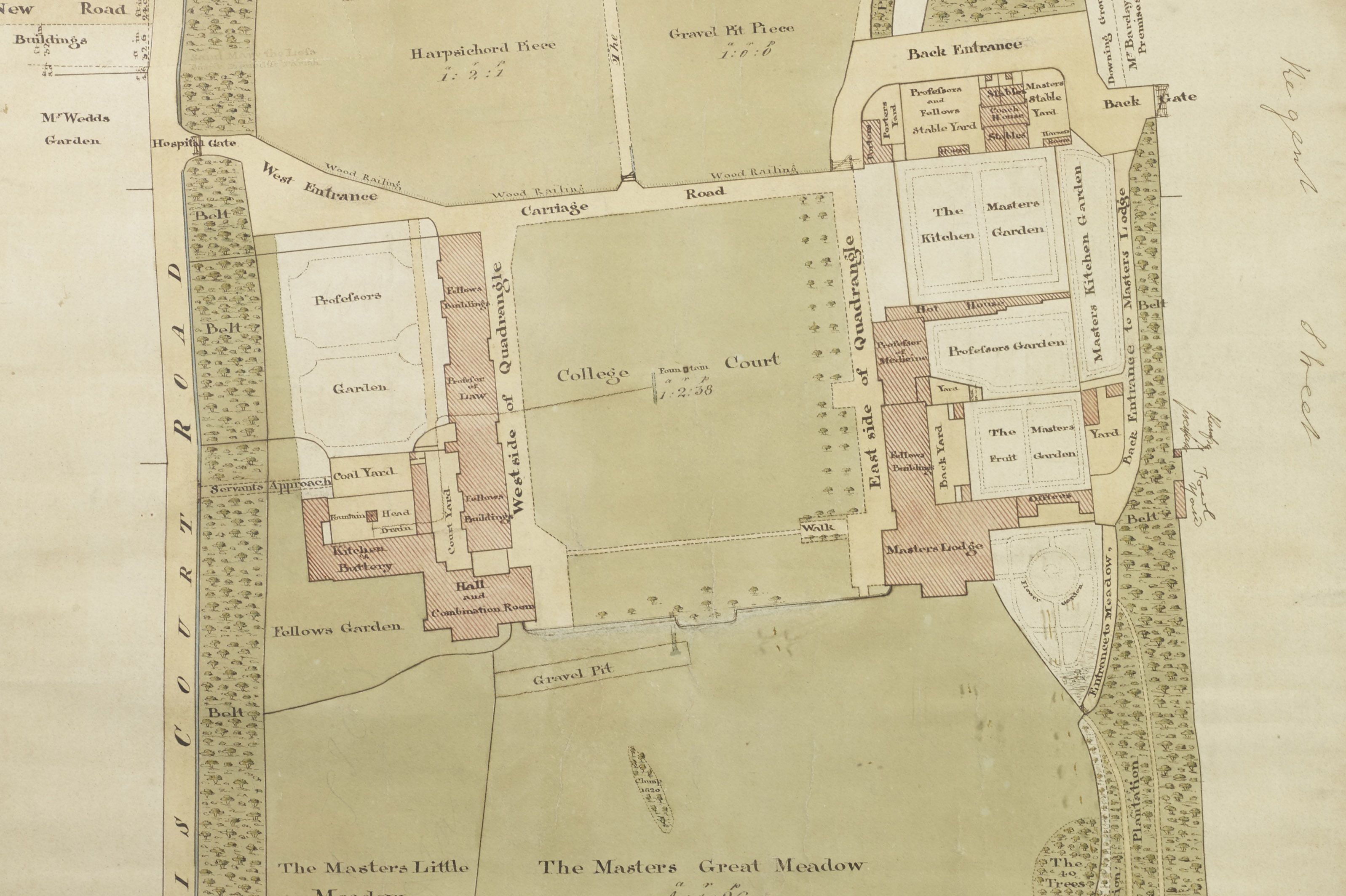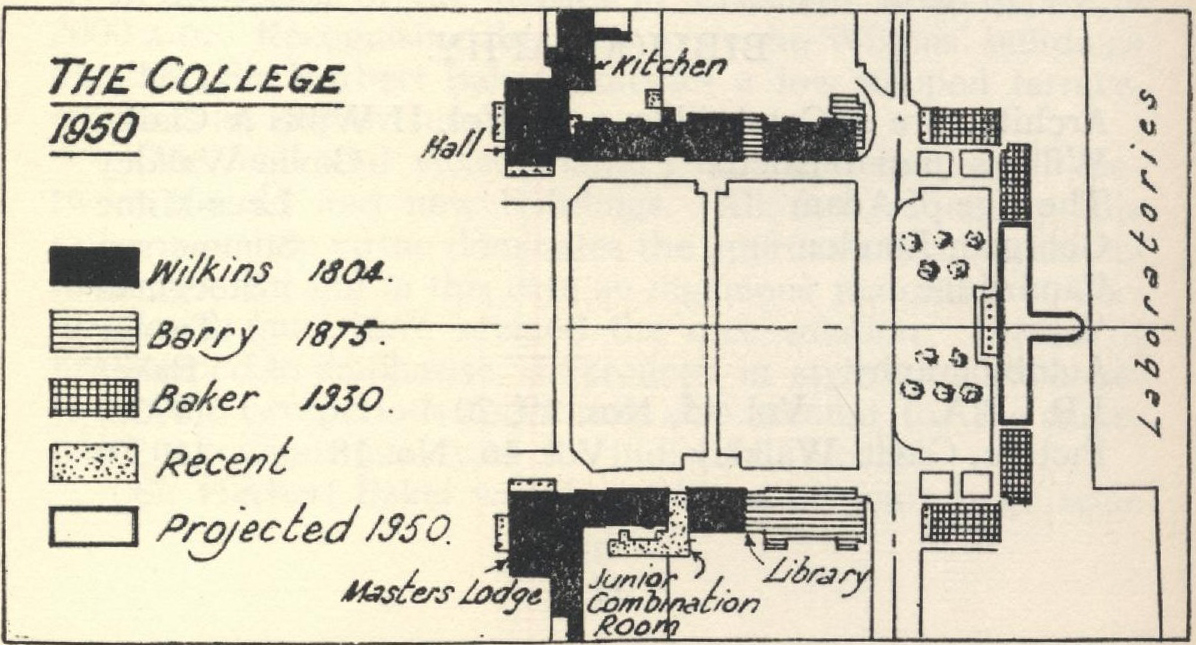Downing College timeline
17th and 18th centuries
1685: Birth of George Downing, later Sir George Downing, third Baronet.
1717 20 Dec: Will of Sir George Downing, stating that if his four named heirs should die with no surviving heirs the estate should be used to found "Downing's College" in Cambridge.
1749 10 June: Death of Sir George Downing.
1764 6 Feb: Death of Sir Jacob Garrard Downing, fourth Baronet, the last living heir in the 1717 will.
The foundation of Downing College should have taken place at this point. However, Sir Jacob's 1763 will named his wife, Lady Margaret Downing, as his executor.
1764 1 May: Bill lodged in Chancery on behalf of the University of Cambridge, primarily against Lady Downing, petitioning for the creation of Downing College.
Lady Downing argued that she was entitled to inherit the estates. Litigation continued against her heirs after her death in 1778, eroding the value of the estates.
19th century
1800 22 Sept: Downing College finally granted a Royal Charter.
1801 to 1807: Purchase of College site, known as Pembroke Leys.
1805 23 Jul: Statutes, rules and ordinances published.
1807 18 May: Foundation stone laid. Work begins on the Master's Lodge.
1811: Master's Lodge and the East Lodge, for the Professor of Medicine, completed.
1812 16 Apr: Death of Francis Annesley, First Master of Downing, succeeded by William Frere.
1813: Completion of six sets of chambers between the two lodges to temporarily accommodate the Professor of Law and 3 Fellows.
1814 10 Nov: Death of Sir Busick Harwood, first Professor of Medicine. He was buried in a vault under the proposed site of the Chapel, in Wilkins' proposed South Range.
1818 May: Admission of the first fee-paying undergraduate, Montagu John Wynyard, appointed Junior Chaplain.
1818 to 1821: Building of the whole of the West Range, including the Hall and the West Lodge.
1819: Room on the ground floor next to the West Lodge designated as the Library.
1820 Mar: First Porter, Thomas Howe, appointed. Porter's Lodge built on the Eastern side of College near the stable block
1820 May: Revd Richard Dawes MA of Trinity College appointed as Chaplain. Dawes also holds the office of Mathematical Lecturer and the vicarage of Tadlow.
1821: Upper room, on the Hall staircase and above the SCR, designated for use as a chapel

Part of the 1822 'Plan of Downing College and Pleasure Grounds' by Wilkins
1825: The West Field designated as the Fellows' Garden.
1834: Current Porter's Lodge built with "erection of iron gates and railings calculated for the admission of carriages and foot passengers."
1836 25 May: Death of William Frere, replaced by Thomas Worsley as Master.
1847 6 July: Queen Victoria and Prince Albert attend Downing’s Horticultural Show.
1861: The introduction of scholarships and exhibitions by the College to attract students leads to the admission of the first fee-paying undergraduates in over 30 years.
1862: First Librarian appointed, John Perkins, Fellow from 1861.
1864: Professor Latham persuades the College to build one of the first College laboratories. This remains in use until 1921.
1873 to 75: Completion of the East Range by architect Edward Barry, with addition of a lecture room to West Lodge for the use of the Professor of Law.
1877: Library moved from West Range to newly completed East Range.
1885: Death of Thomas Worsley. William Lloyd Birkbeck elected as Master.
1888 to 1907: Alex Hill serves as Master of Downing.
1893 12 June: Tchaikovsky stays with F W Maitland in the West Lodge in Downing while in Cambridge for a concert to mark the 50th anniversary of the Cambridge University Musical Society (CUMS).
1895: Downing College Boat House completed.
1895: Downing sells two acres of land on the north boundary with Downing Street to the University for £15,000, the beginnings of the Downing Site.
Development of Lensfield Road boundary, with building of large red-brick houses let by the College on 99-year leases.
1897 to 1901: Gradual sale of more land to the north of the domus to the University leading to the creation of the modern Downing Site.
Early 20th century
1902 to 1903: Demolition of the old stable block on the site of the current Library and building of smaller stable block behind the Porter's Lodge.
1903: Library moves to a large room adjoining the East Lodge, previously the Professor of Medicine's lecture room.
1907 to 1915: Frederick Howard Marsh Master of Downing.
1910 5 March: Petition of 77 students for a purpose-built chapel and additional student rooms, followed by further petition in 1913.
1913: Architect C G Hare appointed to design a permanent chapel and additional student rooms, building appeal launched.
1914: Outbreak of War. Downing College provided accommodation for nurses between August and September.
Student numbers were 61 in 1914, compared with 140 undergraduates in 1913. This number fell to just 16 by 1917.
1915 to 1936: Sir Charles Albert Seward Master of Downing.
1919 8 Mar: Establishment of the College Office. J R C Powney engaged as a Clerk in May 1919.
1920 22 Feb: Memorial service held for members of the College who died during First World War.
War Memorial unveiled, originally in the Hall before being moved to current location after the Second World War. See the First World War Roll of Honour here.
1924: Change in the Charter of 1800 removed the obligation to provide a stipend and Lodge for the Professors of Law and Medicine.
1927: Opening of the College's new baths in O staircase.
1931: Building of Sir Herbert Baker's North Range. The Downing Site was visible between the Baker buildings until the early 1950s, with the addition of the Chapel completing the Northern range.
1932 3 Oct: Formal opening of the Baker buildings and Kenny Gates in Tennis Court Road, in memory of the late Professor Courtney Stanhope Kenny.
1934: Sports Ground opened on Long Road. New Sports Pavilion formally opened May 11 1935.
1935: Land formerly part of Tunbridge Hall Farm at Bottisham sold to Cambridgeshire County Council for new Bottisham Village College.
1936 to 1947: Admiral Sir Herbert William Richmond Master of Downing.
1936 May 15: Opening of new JCR, built at back of East Lodge on site of previous East Lodge kitchen and outhouses, providing two new sets of undergraduate rooms above.
1938: Completion of the renovated Boathouse.
1938 to 1939: Benevolent Fund established to assist undergraduates.
1939: Outbreak of World War Two.
1940 Apr: College sells iron railings between the Paddock and quadrangle for the war effort.
1945: Sister Brady appointed first College Nurse.
1945 15 Sept: Sale of most of West Cambridgeshire agricultural lands acquired by Sir George Downing, mostly to their existing tenants, giving the College more freedom of investment. Sale completed by 1947.
1947 to 1957: Sir Lionel Ernest Howard Whitby Master of Downing.
Richmond Lectures started by Amalgamation Club.
1948 25 Sept: War Memorial unveiled for the 55 students, Fellows and staff who died during Second World War. See the Second World War Roll of Honour here.
Late 20th century
1950: Work begins on new Chapel, modified by Baker's partner Alex Scott and V Helbing.
1950 18 May: Laying of the Chapel inscribed stone.

From a 1950 Griffin article showing the history of the college buildings.
1952 to 1953: Removal of the Naval Hut which served as HQ of the Naval Division during the war, used afterwards by the Medical School.
1953 29 June: Dedication of new Chapel and opening of new buildings.
1957 to 1972: William Keith Chambers Guthrie Master of Downing.
1960 to 1962: Building of two residential blocks, Kenny A and B, following a donation by Agnes Kenny and designed by Scott and Helbing in keeping with the Wilkins designs.
1961 1 Oct: Unveiling of memorial to Sir George Downing, in Croydon church.
1964: Rebuilding and enlargement of D staircase.
1969: New SCR, Kitchens, Buttery and offices, west of the Hall, designed by Howell, Killick, Partridge and Amis and opened by HRH the Duchess of Kent.
1972 to 1978: Sir Morien Bedford Morgan Master of Downing.
1977: Governing Body removed the restriction on the admission of women students and Fellows, leading to the election of the first female Fellow the following year.
1978 to 1987: Baron John Butterfield of Stechford Master of Downing.
1980: First women undergraduates and postgraduates admitted to Downing.
1984: Completion of Parker's House, the redevelopment of College-owned Regent Street properties begun in the early 1980s.
1984 6 Nov: Deed of gift from the Howard Foundation of £850,000 for the Howard Building.
1985 to 1987: Howard Building, designed by Quinlan Terry and built by Coulson and Sons, officially opened by HRH the Duchess of Kent on 6 Oct 1987.
1986 Jan: HRH the Duchess of Kent becomes Patron of the College.
1986 Jan: Author P D James elected to an Associate Fellowship. Introduction of the annual PD James Prize for creative writing, renamed the John Treherne Prize from 1989, funded by Baroness James until her death in 2014.
1987 to 1995: Peter Mathias Master of Downing College
1987 Oct: Development of 16-20 Regent Street, Richmond House, begun by Quinlan Terry.
1987 Oct: Butterfield building begun, again by Mr Terry, to house new JCR.
1989: New rose garden created in former Master's Lodge Kitchen Garden.
1989 to 1990: Extension to the rear of Porter's Lodge and refurbishing of main entrance gates.
1993 22 Nov: Opening of the Maitland Robinson Library, Downing's first purpose-built library, designed by Quinlan Terry and opened by Prince Charles and the Duchess of Kent.
1994: Opening of Howard Court residential building, later Howard Lodge.
1995 to 2001: Sir David Anthony King Master of Downing.
1998 1 Oct: Stephen Chambers begins one year Fellowship as Artist in Residence.
1999 20 Jan: Downing College Developments Ltd incorporated.
21st Century
2000: Bicentenary and opening of Singer Building, providing graduate accommodation and gym facilities.
2001 to 2003: Stephen George Fleet Master of Downing.
2001 Apr: Official reopening of the Boathouse following rebuilding work.
2002: Sale of College sports field on Long Road for development of Addenbrooke's Hospital. Acquisition of land on Barton Road.
2003 to 2013: Barry John Everitt Master of Downing.
2004 14 Jun: Official opening of the new Pavilion by Keith Fletcher, former captain of Essex County Cricket team.
2007 2 Apr: Downing Cambridge Conferences Ltd incorporated.
2007 to 2009: Restoration of the Hall, completed in February 2009.
2010: Completion of the Howard Theatre, designed by Quinlan and Francis Terry, based on the Georgian Theatre Royal, Richmond, with an interior modelled on Wilkins' remaining working theatre in Bury St Edmunds.
2010 28 Jul: The May Ball Company Ltd incorporated.
2012 Oct: Opening of Griphon House, providing high quality rooms for students and out-of-term conference visitors.
2013 to 2014: Renovation of 40-42 Lensfield Rd, D staircase and the Howard Building.
2013 to 2018: Professor Geoffrey Grimmett Master of Downing.
2014: Chapel renovation and installation of new organ by Kenneth Tickell. Start of work on Parker's House and new First Court art gallery.
2014 26 Jun: Official reopening of the Howard Building after refurbishment.
2016 5 Feb: Official opening of the Heong Gallery, named by Alwyn Heong, an alumnus of Downing College. The gallery is part of a larger construction project to create a new court, called First Court, and Battcock Lodge containing 78 student rooms and eight common rooms.
2018 to 2023: Mr Alan Bookbinder Master of Downing.
2023 2 Oct: Professor Graham Virgo becomes the 19th Master of Downing.
